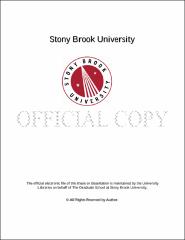| dc.identifier.uri | http://hdl.handle.net/11401/77059 | |
| dc.description.sponsorship | This work is sponsored by the Stony Brook University Graduate School in compliance with the requirements for completion of degree. | en_US |
| dc.format | Monograph | |
| dc.format.medium | Electronic Resource | en_US |
| dc.language.iso | en_US | |
| dc.publisher | The Graduate School, Stony Brook University: Stony Brook, NY. | |
| dc.type | Dissertation | |
| dcterms.abstract | Tuberculosis, responsible for 1.5 million deaths worldwide in 2014, is treated using first and second line drugs. The repertoire of treatments has remained virtually static for decades, but the prevalence of drug resistance has increased. The rise of MDR- and XDR-TB has rendered current treatments ineffective, and new anti-tubercular agents with unique mechanisms of action are needed to overcome this hurdle. Filamenting temperature-sensitive mutant Z (FtsZ) is an essential bacterial cell division protein and a promising target. Inhibition of FtsZ will disrupt cell division, killing bacterial cells. Libraries of 2,5,6- and 2,5,7-trisubstituted benzimidazoles were previously synthesized and tested against Mtb H37Rv. Lead compounds enhanced GTPase activity, inhibited polymerization, and promoted depolymerization of FtsZ. For further optimization studies and to diversify our database, a new library of 2,5,6-trisubstituted benzimidazoles, containing a dimethylamino substitution at the 6-position and different substitutions at the 2-position, was synthesized and tested for in vitro activity. The synthesis, biological evaluations, and SAR of these novel benzimidazoles will be presented. Anandamide (AEA), an endocannabinoid, is linked to the regulation of stress, pain and inflammation. It activates cannabinoid receptors (CB receptors) on the cell surface, leading to pain relief. Through diffusion, anandamide also enters cells, where fatty acid binding protein 5 (FABP5) and fatty acid binding protein 7 (FABP7) transport anandamide for inactivation by fatty acid amide hydrolase (FAAH). Inhibition of FABP5 and FABP7 will arrest inactivation of the endocannabinoid, lead to higher extracellular anandamide levels, and result in anti-inflammatory and anti-nociceptive effects. Based on these observations, FABP5 and FABP7 make good drug targets. Prior work from our laboratories has determined the crystal structures of FABP5 in complex with AEA, 2-arachidonoylglycerol (2-AG), and SB-FI-26, the current lead compound. The structure of FABP5-SB-FI-26 co-crystal revealed only one enantiomer of SB-FI-26 was present in the binding site of FABP5, prompting the optical resolution of SB-FI-26. In addition, new SB-FI-26 analogues have been designed based on the crystal structure of the FABP5-SB-FI-26 complex, and synthesized to optimize potency. The design and synthesis of novel α-truxillic acid derivatives, as well as optical resolution of SB-FI-26, their biological evaluations, and SAR studies will be presented. | |
| dcterms.abstract | Tuberculosis, responsible for 1.5 million deaths worldwide in 2014, is treated using first and second line drugs. The repertoire of treatments has remained virtually static for decades, but the prevalence of drug resistance has increased. The rise of MDR- and XDR-TB has rendered current treatments ineffective, and new anti-tubercular agents with unique mechanisms of action are needed to overcome this hurdle. Filamenting temperature-sensitive mutant Z (FtsZ) is an essential bacterial cell division protein and a promising target. Inhibition of FtsZ will disrupt cell division, killing bacterial cells. Libraries of 2,5,6- and 2,5,7-trisubstituted benzimidazoles were previously synthesized and tested against Mtb H37Rv. Lead compounds enhanced GTPase activity, inhibited polymerization, and promoted depolymerization of FtsZ. For further optimization studies and to diversify our database, a new library of 2,5,6-trisubstituted benzimidazoles, containing a dimethylamino substitution at the 6-position and different substitutions at the 2-position, was synthesized and tested for in vitro activity. The synthesis, biological evaluations, and SAR of these novel benzimidazoles will be presented. Anandamide (AEA), an endocannabinoid, is linked to the regulation of stress, pain and inflammation. It activates cannabinoid receptors (CB receptors) on the cell surface, leading to pain relief. Through diffusion, anandamide also enters cells, where fatty acid binding protein 5 (FABP5) and fatty acid binding protein 7 (FABP7) transport anandamide for inactivation by fatty acid amide hydrolase (FAAH). Inhibition of FABP5 and FABP7 will arrest inactivation of the endocannabinoid, lead to higher extracellular anandamide levels, and result in anti-inflammatory and anti-nociceptive effects. Based on these observations, FABP5 and FABP7 make good drug targets. Prior work from our laboratories has determined the crystal structures of FABP5 in complex with AEA, 2-arachidonoylglycerol (2-AG), and SB-FI-26, the current lead compound. The structure of FABP5-SB-FI-26 co-crystal revealed only one enantiomer of SB-FI-26 was present in the binding site of FABP5, prompting the optical resolution of SB-FI-26. In addition, new SB-FI-26 analogues have been designed based on the crystal structure of the FABP5-SB-FI-26 complex, and synthesized to optimize potency. The design and synthesis of novel α-truxillic acid derivatives, as well as optical resolution of SB-FI-26, their biological evaluations, and SAR studies will be presented. | |
| dcterms.available | 2017-09-20T16:51:48Z | |
| dcterms.contributor | Drueckhammer, Dale G | en_US |
| dcterms.contributor | Ojima, Iwao | en_US |
| dcterms.contributor | Lauher, Joseph W | en_US |
| dcterms.contributor | Deutsch, Dale G. | en_US |
| dcterms.creator | Tong, Simon | |
| dcterms.dateAccepted | 2017-09-20T16:51:48Z | |
| dcterms.dateSubmitted | 2017-09-20T16:51:48Z | |
| dcterms.description | Department of Chemistry | en_US |
| dcterms.extent | 368 pg. | en_US |
| dcterms.format | Monograph | |
| dcterms.format | Application/PDF | en_US |
| dcterms.identifier | http://hdl.handle.net/11401/77059 | |
| dcterms.issued | 2016-12-01 | |
| dcterms.language | en_US | |
| dcterms.provenance | Made available in DSpace on 2017-09-20T16:51:48Z (GMT). No. of bitstreams: 1
Tong_grad.sunysb_0771E_12982.pdf: 19854109 bytes, checksum: 3ced8336c8a84fb42913849dae225ae1 (MD5)
Previous issue date: 1 | en |
| dcterms.publisher | The Graduate School, Stony Brook University: Stony Brook, NY. | |
| dcterms.subject | Anandamide, Benzimidazole, FABP, FtsZ, Tuberculosis, α-truxillic acid | |
| dcterms.subject | Chemistry | |
| dcterms.subject | Anandamide, Benzimidazole, FABP, FtsZ, Tuberculosis, α-truxillic acid | |
| dcterms.title | Development of Antitubercular Agents Targeting FtsZ and Antinociceptive Agents Targeting Fatty Acid Binding Proteins (FABP) | |
| dcterms.type | Dissertation | |

